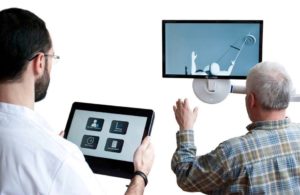Virtual Reality And Gaming Technology Helps Stroke Patients Recover
NeuroRehab Team
Tuesday, November 15th, 2016
NeuroplasticityVirtual Reality

There is strong evidence that repetitive task specific training techniques improve upper extremity function. Task training yields long lasting cortical reorginization specific to the corresponding areas being used. Traditional treatment interventions are based primarily on routine exercises and/or purposeful activities. For many patients, the road to recovery is long and difficult and clinicians are challenged with the daunting task of maintaining patient motivation and compliance while alleviating boredom. Computer based games and virtual reality have recently emerged as novel strategies to maintain motivation and compliance while providing the necessary repetitive training.
Best Way to Find Stroke Gaming Technology
Virtual Reality and Gaming Technology for Rehabilitation
Virtual reality and computerized gaming for rehabilitation have become increasingly popular over the recent years. Clinicians can use these technologies for a wide range of impairments that address numerous areas including:
- Sensory
- Visual/Perception
- Cognition
- Motor
- Communication
- Emotional
- Social
- Pain
Virtual Reality vs. Gaming Technology
- Computer-based exercise games (exergames) are video games that are also a form of exercise. They allow players to engage in entertaining activities defined by rules that result in a quantifiable outcome (score). The user exerts effort in order to influence the outcome.
- These games rely on technology that tracks body movements or reactions.
- Some clinically advanced games allow users to set goals, grade and customize, receive instantaneous feedback, reinforce behaviors, and record and analyze results.
- Virtual reality is a computer-based, interactive, multisensory simulation environment that occurs in real time. It provides users with opportunities to participate in activities within environments that appear similar to real-world objects and events.
- Virtual reality systems typically places the user in a three-dimensional environment where the intensity of feedback and training can be manipulated.
- There are 2 types of virtual environments:
- Immersive
- Non-immersive
Immersive vs. Non-immersive Virtual Reality
- Immersive: the user has a strong sense of presence. The virtual environment is delivered by equipment worn by the user or the person is situated within a virtual environment. Full immersive systems use head-mounted displays, special gloves, and large concave screen projections to create the sense of immersion.
- Non-immersive: usually two-dimensional and delivered through a computer screen. The user controls devices such as a joystick, mouse, or sensors.
Virtual reality and interactive video gaming have emerged as new treatment approaches in stroke rehabilitation settings over the last ten years. Recent evidence indicates that intensive massed practice can stimulate recovery of motor skills in patients following stroke. Virtual reality may be useful to augment rehabilitation of the upper limb in patients suffering from stroke and other neurological injuries.

